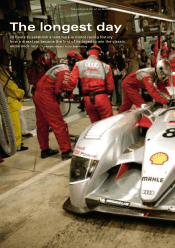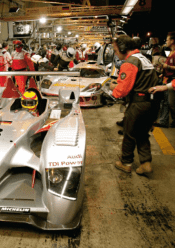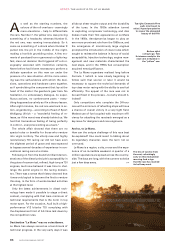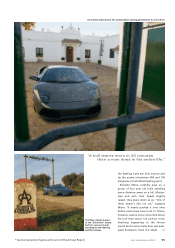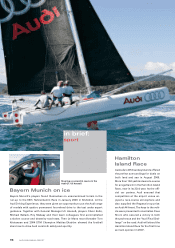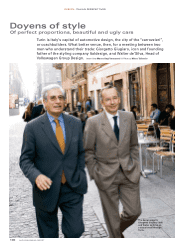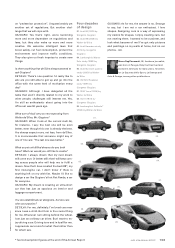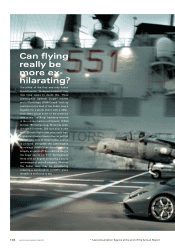Audi 2006 Annual Report Download - page 96
Download and view the complete annual report
Please find page 96 of the 2006 Audi annual report below. You can navigate through the pages in the report by either clicking on the pages listed below, or by using the keyword search tool below to find specific information within the annual report.
Three generations of a legendary family of
breeders: (from left) Eduardo Miura, his son
Eduardo and brother Antonio, with the
painted tiles above them depicting grand-
father Antonio in the saddle.
SPORT: AN AUTOMOTIVE ARISTOCRAT IN THE LAND OF THE BULL
94 AUDI 2006 ANNUAL REPORT
The Lamborghini Murciélago car-
ries us along old country roads
along the Rio Guadalquivir,
towards Córdoba. The river brings life to
Andalusia’s expansive, arid landscape.
Traffic trickles along like the final few
drops in a bottle of Osborne sherry. The
twelve-cylinder engine booms out its
symphony for our ears only. Every gear
change sets the skin tingling.
The sheer bestial power of the
Lamborghini seems appropriate in this
harsh country. The Murciélago owes its
name to a particularly brave fighting
bull that wrote history in the bullfight-
ing world on October 5, 1879. After the
noble and courageous beast had en-
gaged the torero in a drawn-out strug-
gle, the crowd in Córdoba asked for
the animal’s life to be spared – a rare
gesture indeed. After the fight, the bull
passed into the ownership of the bull
breeder Antonio Miura, who made it the
progenitor of a legendary breed of fight-
ing bulls.
Sun-bleached bull’s skulls leading
the way
The gateway to the realm of the Miuras
is to be found on a lonely road, a couple
of kilometres from Lora del Río. It con-
sists of simple wooden posts support-
ing two sun-bleached bull’s skulls and
the name “Miura” spelled out in sticks.
A weathered milestone displays the
letter “A”, adorned with two symbolic
horns – the Miuras’ coat of arms.
“Zahariche” is the name of the estate
hidden well behind it. The Miuras, a dy-
nasty of bull breeders, have been living
here since 1842 and have earned a place
in the heart of every Spaniard. The name
Miura is uttered with immense respect.
Only once before has a Lamborghini
visited here – and that time, it was
driven by the boss himself. Ferruccio
Lamborghini called in on Eduardo Miura
Fernández in the 1960s. The outcome of
his visit was a legendary name in the
motoring world: Lamborghini Miura.
Today, the family business at
Zahariche is run by his sons Eduardo
and Antonio Miura. There are many
hundreds of adolescent bulls, oxen,
cows and calves grazing more than
600 hectares of land. The Miuras wear
Spanish riding boots with jangling
spurs. Saddled horses are tethered to a
fig tree. The brothers have regularly
been riding since the age of five. The
sound of hooves thunders over from a
group of riders dashing across the vast
meadow at a gallop.
“Vaqueros” is the name given to these
Andalusian cowboys. They sit proud
and upright in their saddles, bearing
wooden lances. In such surroundings,
our Murciélago LP640 Coupé* really does
look like a visitor from another planet.
Eduardo Miura invites us to climb into
his battered old off-road vehicle and
join him on a beginner’s course in bull-
breeding, warning us not even to think
of getting out: “You should be under no
illusions, a three year old novillo can
already be very dangerous to a man.”
We pass a small arena (“tentadero”) in
which tests for selected animals are be-
ing held. One particular iron rule applies
here: a man should never approach a
designated fighting bull on foot (as the
torero will subsequently do), with a
capa or muleta. “A bull,” explains Miura,
“learns more in 20 minutes than a man
does in his entire life”. A bull that has
already worked out the rules of engage-
ment would trample any torero into the
ground straight away. At the age of four,


